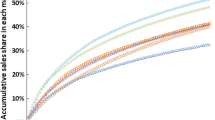Abstract
Cross-national price comparisons for pharmaceuticals are commonly used for two purposes. Comparisons based on a sample of products are used to draw conclusions about differences in average price levels. Cross-national comparisons applied to individual products are also used by governments to set domestic prices.
This paper examines the major methodological issues raised by international price comparisons, focusing on measurement of differences in average price levels and the validity of policy conclusions drawn from such price comparison studies. It argues that valid measures of average price levels can only be obtained from comparisons based on a comprehensive or representative sample of products, appropriately weighted, following standard index number methods. Comparisons of individual product prices should take into account the manufacturer’s entire product portfolio over time rather than focus narrowly on a single product at a point in time.
Because of the great variation across countries in both the range of drug compounds available and the dosage forms, strengths and pack sizes for each compound, obtaining a broadly comprehensive or representative sample is problematical. If products are required to match on all dimensions, including molecule, manufacturer, strength and pack, as is common in most international price comparisons, then only a very small and unrepresentative sample of the drugs available in each country can be included in the analysis. A trade-off between the desire to compare only identical products and the need to compare a truly representative sample of a country’s pharmaceutical market is therefore necessary. A valid comparison of average drug prices should include generics and over-the-counter products that are good substitutes for branded prescription drugs, with all forms, strengths and packs. To achieve this broad representation, however, the requirements of same manufacturer, same brand, dosage form, strength and pack size must be dropped.
When such an approach is taken to the comparison of international drug prices, quite different results from those obtained from less comprehensive comparisons may be obtained. Indeed, a major conclusion of this analysis is that international drug price comparisons are extremely sensitive to choices made about certain key methodological issues, such as sample selection, unit of measurement for price and volume, the relative weight given to consumption patterns in the countries being compared, and the use of exchange rates or purchasing power parities for currency conversion. In particular, the results of this analysis indicate that recent reports suggesting that manufacturer prices in the US are 32% higher than in Canada and 60% higher than in the UK are in fact overstatements which arise from limitations of the sample and methods used to calculate these price differentials.
Similar content being viewed by others
References
US General Accounting Office. Prescription drugs: companies typically charge more in the United States than in Canada. GAO/HRD-92-110, 1992
US General Accounting Office. Prescription drugs: companies typically charge more in the United States than in the United Kingdom. GAO/HEHS-94-29, Jan 12, 1994
US Government Printing Office. Health Security Act. HR 3600 IH/S 1757, 1993
Danzon PM. The economics of parallel trade. Pharmacoeconomics 1998; 13(3): 293–304
Diewert WE. Index numbers. In: Eatwell J, Milgate M Newman P, editors. The new Palgrave dictionary of economics. New York: MacMillan, 1987
Berndt E, Griliches Z, Rosett J. Auditing the producer price index microevidence from prescription pharmaceutical preparations. J Bus Econ Stat 1993; 11(3): 251–64
Andersson F. Methodological aspects of international drug price comparisons. Pharmacoeconomics 1993; 4(4): 247–56
Danzon PM. The uses and abuses of international price comparisons. In: Helms RB, editor. Competitive strategies in the pharmaceutical industry. Washington DC: The American Enterprise Institute Press, 1996
Rozek RP. A critique of the GAO report on the differences in prices for prescription drugs between Canada and the United States. J Res Pharm Econ 1995; 6(1): 77–91
Diewert WE. The theory of the cost-of-living index and the measurement of welfare change. In: Diewert WE, Montmarquette C, editors. Price level measurement. Ottawa: Statistics Canada, 1983: 163–233
Diewert WE. The theory of the output price index and the measurement of real output change. In: Diewert WE, Montmarquette C, editors. Price level measurement. Ottawa: Statistics Canada, 1983; 1049–113
Diewert WE. Microeconomic approaches to the theory of international comparisons. Technical Working Paper No. 53. Cambridge, Mass: National Bureau of Economic Research, 1986
Barral E. Twenty years of pharmaceutical research results throughout the world. Paris: Fondation Rhône-Poulenc Santé, 1995
Griliches Z, Cockburn I. Generics and new goods in pharmaceutical price indexes. Am Econ Rev 1994; 84(5): 213–32
Danzon PM, Chao LW. Does regulation drive out competition in the pharmaceutical market? Working Paper. Philadelphia: University of Pennsylvania, The Wharton School, 1998
Danzon PM, Kim JD. Price indexes for pharmaceuticals: how accurate are international comparisons? Working Paper. Philadelphia: University of Pennsylvania, The Wharton School, 1996
Danzon PM. Reference pricing of pharmaceuticals in Japan: lessons from abroad. Working Paper. Philadelphia: University of Pennsylvania, The Wharton School, 1998
Danzon PM. Defined daily doses for pharmaceuticals: risks and potential. Working Paper. Philadelphia: University of Pennsylvania, The Wharton School, 1996
Manning R. Products liability and prescription drug prices in Canada and the United States. J Law Econom 1997 Apr; 40: 203–243
Thomas III LG. Industrial policy and international competitiveness in the pharmaceutical industry. In: Helms RB, editor. Competitive strategies in the pharmaceutical industry. Washington DC: The American Enterprise Institute Press, 1996
Danzon PM, Percy A. The effects of price regulation on productivity in pharmaceuticals. Working Paper. Philadelphia: University of Pennsylvania, The Wharton School. In: Studies inIncome and Wealth. Chicago: NBER. In Press
Author information
Authors and Affiliations
Rights and permissions
About this article
Cite this article
Danzon, P.M., Kim, J.D. International Price Comparisons for Pharmaceuticals. Pharmacoeconomics 14 (Suppl 1), 115–128 (1998). https://doi.org/10.2165/00019053-199814001-00014
Published:
Issue Date:
DOI: https://doi.org/10.2165/00019053-199814001-00014




